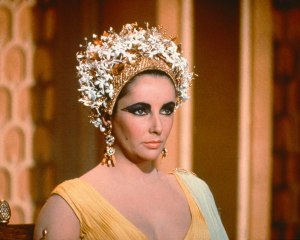
Fashion is all about drama and Cleopatra’s life was full of it, from her legendary affairs with some of the most powerful men of their time to her struggles to maintain influence as ruler of Egypt. Even her death was not a quiet affair—a series of miscommunications led to both her and her lover Mark Antony committing suicide while believing that the other had already died, in a Romeo and Juliet-like twist. As a figure that was exotic (queen of a distant-seeming land) and yet accessible (she was not ethnically Egyptian but Macedonian), she was and has remained a singular influence in the world of style.
The extent of her beauty, based on statements from her contemporaries and numismatic artifacts, is debatable. But Cleopatra was by all accounts an exceptionally charming woman, one who intuited how to present herself in the most strategic manner. Similar to stars of today, Cleopatra carefully controlled her public image. When she traveled to Tarsus by barge to meet Mark Antony for the first time, she created quite a spectacle, dressed as the Egyptian goddess Isis with handsome boys fanning her as she reclined on her perch. Clearly the lady had a taste for pageantry—something a star like Lady Gaga would no doubt appreciate.
(MORE: Here’s What a $1.5 Million, 24-Karat Gold Dress Looks Like)
Cleopatra skillfully combined both Greek and Egyptian elements in her wardrobe. Today’s peplum is descended from the ancient Greek peplos style, a long tube-like garment belted at the waist and cleverly folded to give the illusion of a flared piece of fabric at the hips. But the Queen of the Nile mixed these more modest gowns with seductive Egyptian fashions, much in the same way that modern women mix designers and styles both high and low. As depicted in art, her hair was perfectly coiffed and attended to, often arranged in the “melon hairstyle” of her day which combined multiple braids into a bun at the nape of the neck, akin to a complicated updo today.
She was known to wear copious amounts of perfume, a predilection perhaps passed down to her silver screen counterpart Elizabeth Taylor, who would go on to make millions off her signature perfume White Diamonds. And the black kohl eyeliner Cleopatra (and many other Egyptian women) wore in a cat-eye style has stood the test of time; the smoky, heavily-lined eye is still popular today. She often wore blue or green eyeshadow on her lids for a pop of color that contemporary makeup artists would recognize.
But perhaps the best-known visual depiction of Cleopatra is not found in a museum or painting, but in Hollywood. “In the contemporary imagination, the [1963 Elizabeth Taylor/Richard Burton] movie powerfully brought images of Cleopatra which are still very present and seductive,” says Dr. Hazel Clark, Research Chair of Fashion and Professor in the MA Fashion Studies program at Parsons The New School for Design. “That image” of Taylor, says Dr. Clark, “was very much linked to the early 1960s. I think there’s been a revived interest in the early 1960s, with the popularity of Mad Men and stores like Banana Republic picking up the look.”
(MORE: Armani Invites Emerging Designers to Show in His Milan Venue)
With 65 costume changes, Taylor definitely took the film’s fashion seriously—and so did critics, for it won an Oscar for Best Costume Design. A penchant for shimmery metallic fabrics, one-shouldered gowns and Grecian draping and heavy, ornate bib necklaces all combine to make Taylor’s Cleopatra a fashion icon who still resonates today.
The decadent jewels Cleopatra adorned herself with in the film were designed by Bulgari. The Italian jeweler’s similar Serpenti collection, in which snakes form bracelets and necklaces, is still a bestseller. And the thick cuff bracelets and armbands that Cleopatra sports were perhaps the precursor to the “arm parties” of today.
Much as “the discovery of Tutankhamun’s tombs in 1922 served as inspiration for the Art Deco movement,” Clark points out, our image of Cleopatra from the film revived interest in the styles of ancient Egypt. And the fact that Taylor herself was a well-known actress and personality fueled this: “The whole celebrity fascination or obsession was very much what caught the public’s imagination—not just with Elizabeth Taylor as Cleopatra, but with Elizabeth Taylor as Elizabeth Taylor.” The persistent mythology of this powerful female pharaoh combined with the allure of the beautiful violet-eyed actress who personified her onscreen, make the figure of Cleopatra an enduring sartorial influence.
PHOTOS: Diamond Dogs: 50 Years of Terry O’Neill’s Stunning Images


